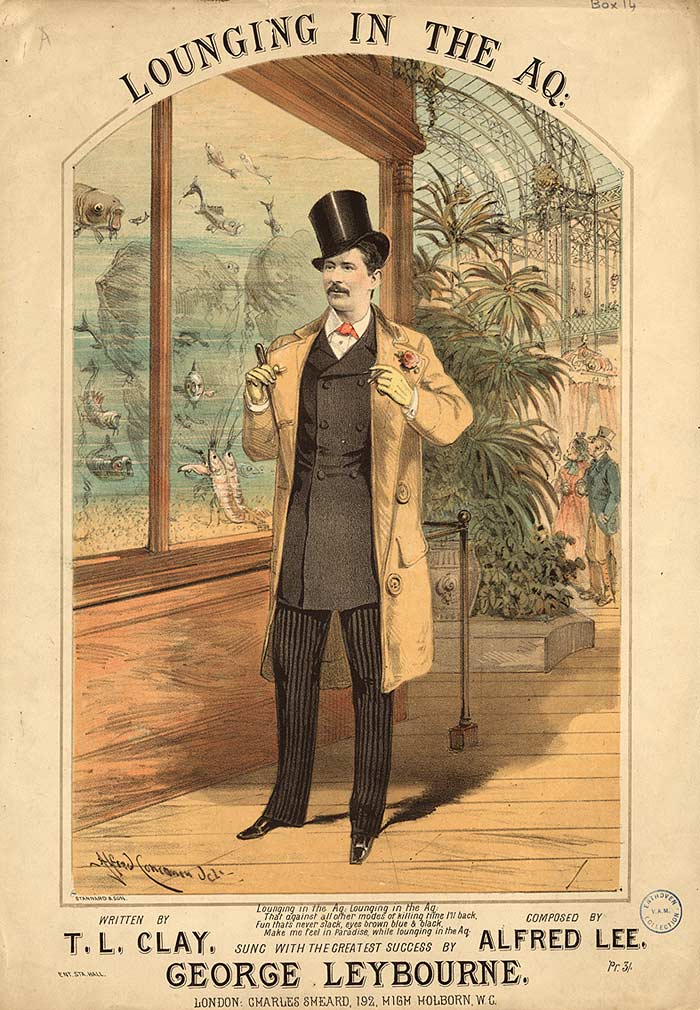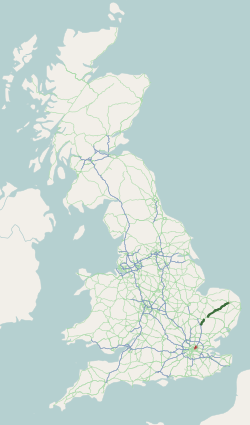|
Aldgate Pump
Aldgate Pump is a historic former water pump located at the junction where Aldgate High Street meets Fenchurch Street and Leadenhall Street in the City of London. The pump is considered to be the symbolic start point of the East End of London. The pump is also notable for its long and sometimes dark history, along with its significant cultural references. Design Aldgate Pump is a Grade II listed structure. The metal wolf head on the pump's spout is supposed to signify the last wolf shot in the City of London. Historic photographs show that the pump was surmounted by an ornate wrought iron lantern. During the 20th century this was removed, but was recreated by the Bottega Prata workshop in Bologna, Italy, during its restoration by the Heritage of London Trust, unveiled in September 2019. The pump can no longer be used to draw water, but a drainage grating is still in place. History As a well, it was mentioned during the reign of King John in the early 13th century. [...More Info...] [...Related Items...] OR: [Wikipedia] [Google] [Baidu] |
Water Main
A water distribution system is a part of water supply network with components that carry potable water from a centralized treatment plant or wells to consumers to satisfy residential, commercial, industrial and fire fighting requirements. Definitions Water distribution network is the term for the portion of a water distribution system up to the service points of bulk water consumers or demand nodes where many consumers are lumped together. The World Health Organization (WHO) uses the term water transmission system for a network of pipes, generally in a tree-like structure, that is used to convey water from water treatment plants to service reservoirs, and uses the term water distribution system for a network of pipes that generally has a loop structure to supply water from the service reservoirs and balancing reservoirs to consumers. Components A water distribution system consists of pipelines, storage facilities, pumps, and other accessories. Pipelines laid within public ... [...More Info...] [...Related Items...] OR: [Wikipedia] [Google] [Baidu] |
Lion Comique
The ''lion comique'' was a type of popular entertainer in the Victorian music halls, a parody of upper-class toffs or "swells" made popular by Alfred Vance and G. H. MacDermott, among others. They were artistes whose stage appearance, resplendent in evening dress (generally white tie White tie, also called full evening dress or a dress suit, is the most formal evening Western dress code. For men, it consists of a black tail coat (alternatively referred to as a dress coat, usually by tailors) worn over a white dress shir ...), contrasted with the cloth-cap image of most of their music-hall contemporaries. According to Michael Kilgarriff, it was J. J. Poole, manager of the South London Music Hall, who first described the performer George Leybourne as "a Lion of a Comic". Victorian fashion then led to the use of the French words, ''lion comique'', which in turn became a generic term for all performers with an imposing appearance and personality.Michael Kilgarriff, ''G ... [...More Info...] [...Related Items...] OR: [Wikipedia] [Google] [Baidu] |
The Uncommercial Traveller
''The Uncommercial Traveller'' is a collection of literary sketches and reminiscences written by Charles Dickens, published in 1860–1861. In 1859 Dickens founded a new journal called ''All the Year Round'', and the "Uncommercial Traveller" articles would be among his main contributions. He seems to have chosen the title and persona of the Uncommercial Traveller as a result of a speech he gave on 22 December 1859 to the Commercial Travellers' School in London, in his role as honorary chairman and treasurer. The persona sits well with a writer who liked to travel, not only as a tourist, but also to research and report what he found visiting Europe, America and giving book readings throughout Britain. He did not seem content to rest late in his career when he had attained wealth and comfort and continued travelling locally, walking the streets of London in the mould of the flâneur, a "gentleman stroller of city streets". He often suffered from insomnia and his night-time wanderin ... [...More Info...] [...Related Items...] OR: [Wikipedia] [Google] [Baidu] |
Charles Dickens
Charles John Huffam Dickens (; 7 February 1812 – 9 June 1870) was an English novelist, journalist, short story writer and Social criticism, social critic. He created some of literature's best-known fictional characters, and is regarded by many as the greatest novelist of the Victorian era.. His works enjoyed unprecedented popularity during his lifetime and, by the 20th century, critics and scholars had recognised him as a literary genius. His novels and short stories are widely read today. Born in Portsmouth, Dickens left school at age 12 to work in a boot-blacking factory when his father John Dickens, John was incarcerated in a debtors' prison. After three years, he returned to school before beginning his literary career as a journalist. Dickens edited a weekly journal for 20 years; wrote 15 novels, five novellas, hundreds of short stories and nonfiction articles; lectured and performed Penny reading, readings extensively; was a tireless letter writer; and campaigned vigor ... [...More Info...] [...Related Items...] OR: [Wikipedia] [Google] [Baidu] |
Cheque
A cheque (or check in American English) is a document that orders a bank, building society, or credit union, to pay a specific amount of money from a person's account to the person in whose name the cheque has been issued. The person writing the cheque, known as the ''drawer'', has a transaction banking account (often called a current, cheque, chequing, checking, or share draft account) where the money is held. The drawer writes various details including the monetary amount, date, and a payee on the cheque, and signs it, ordering their bank, known as the ''drawee'', to pay the amount of money stated to the payee. Although forms of cheques have been in use since ancient times and at least since the 9th century, they became a highly popular non-cash method for making payments during the 20th century and usage of cheques peaked. By the second half of the 20th century, as cheque processing became automated, billions of cheques were issued annually; these volumes peaked in or a ... [...More Info...] [...Related Items...] OR: [Wikipedia] [Google] [Baidu] |
Rhyming Slang
Rhyming slang is a form of slang word construction in the English language. It is especially prevalent among Cockneys in England, and was first used in the early 19th century in the East End of London; hence its alternative name, Cockney rhyming slang. In the US, especially the criminal underworld of the West Coast of the United States, West Coast between 1880 and 1920, rhyming slang has sometimes been known as Australian slang. The construction of rhyming slang involves replacing a common word with a phrase of two or more words, the last of which rhymes with the original word; then, in almost all cases, omitting, from the end of the phrase, the secondary rhyming word (which is thereafter implied), Bryson, a humourist, states that there is a special name given to this omission: "the word that rhymes is almost always dropped... There's a technical term for this process as well: hemiteleia". Given that this is a genus of plant species, and appears in no readily available sources a ... [...More Info...] [...Related Items...] OR: [Wikipedia] [Google] [Baidu] |
Cockney
Cockney is a dialect of the English language, mainly spoken in London and its environs, particularly by Londoners with working-class and lower middle class roots. The term ''Cockney'' is also used as a demonym for a person from the East End, or, traditionally, born within earshot of Bow Bells. Estuary English is an intermediate accent between Cockney and Received Pronunciation, also widely spoken in and around London, as well as in wider South Eastern England. In multicultural areas of London, the Cockney dialect is, to an extent, being replaced by Multicultural London English—a new form of speech with significant Cockney influence. Words and phrases Etymology of ''Cockney'' The earliest recorded use of the term is 1362 in passus VI of William Langland's ''Piers Plowman'', where it is used to mean "a small, misshapen Egg as food, egg", from Middle English ''coken'' + ''ey'' ("a rooster, cock's egg"). Concurrently, the List of mythological places, mythical land of luxury Co ... [...More Info...] [...Related Items...] OR: [Wikipedia] [Google] [Baidu] |
East Anglia
East Anglia is an area of the East of England, often defined as including the counties of Norfolk, Suffolk and Cambridgeshire, with parts of Essex sometimes also included. The name derives from the Anglo-Saxon kingdom of the East Angles, a people whose name originated in Anglia (Angeln), in what is now Northern Germany. East Anglia is a predominantly rural region and contains mainly flat or low-lying and agricultural land. The area is known for considerable natural beauty. It shares a long North Sea coastline and contains one of the ten national parks in England, The Broads. Norwich is the largest city in the region. Area Definitions of what constitutes East Anglia vary. The Anglo-Saxon Kingdom of East Anglia, established in the 6th century, originally consisted of the modern counties of Norfolk and Suffolk and expanded west into at least part of Cambridgeshire, typically the northernmost parts known as The Fens. The modern NUTS 2 statistical unit of East Anglia compri ... [...More Info...] [...Related Items...] OR: [Wikipedia] [Google] [Baidu] |
Essex
Essex ( ) is a Ceremonial counties of England, ceremonial county in the East of England, and one of the home counties. It is bordered by Cambridgeshire and Suffolk to the north, the North Sea to the east, Kent across the Thames Estuary to the south, Greater London to the south-west, and Hertfordshire to the west. The largest settlement is Southend-on-Sea, and the county town is Chelmsford. The county has an area of and a population of 1,832,751. After Southend-on-Sea (182,305), the largest settlements are Colchester (130,245), Basildon (115,955) and Chelmsford (110,625). The south of the county is very densely populated, and the remainder, besides Colchester and Chelmsford, is largely rural. For local government purposes Essex comprises a non-metropolitan county, with twelve districts, and two unitary authority areas: Thurrock Council, Thurrock and Southend-on-Sea City Council, Southend-on-Sea. The districts of Chelmsford, Colchester and Southend have city status. The county H ... [...More Info...] [...Related Items...] OR: [Wikipedia] [Google] [Baidu] |
A11 Road (England)
The A11 is a major trunk road in England. It originally ran roughly north east from London to Norwich, Norfolk. It now consists of a short section in Inner London and a much longer section in Cambridgeshire, Suffolk and Norfolk. The lengthy section between these was renumbered as a result of the opening of the M11 in the 1970s and then the A12 extension in 1999. It also multiplexes/overlaps with the A14 on the Newmarket bypass. Route City of London All this part has been declassified and is now a minor road. Thus the A11 now starts at Aldgate, just inside the eastern boundary of the City of London. The first stretch is Whitechapel High Street, east of the junction with Mansell Street. In a complex reworking of the roads since the days of the Aldgate gyratory system, it is two-way, but the east-bound section is part of the ring-road that retained a one-way system south of this junction, but the westbound section is for local access and motorists have to U-turn to avoid e ... [...More Info...] [...Related Items...] OR: [Wikipedia] [Google] [Baidu] |




